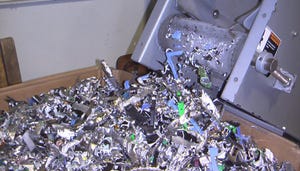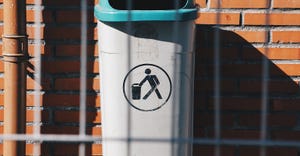COLLECTION: Study Reshapes Waste Plan At Naval Air Station
August 1, 1994
Charles D. Forbes, John S. Savage
True to its naval spirit, the Patuxent River, Md., Naval Air Station (NAS) is strategically planning to manage solid waste and comply with local county recycling goals.
The Patuxent River Naval Air Station, a 6,000-acre site, is the Navy's principal aircraft research, development and testing facility. The base accommodates more than 5,000 residents, employs 13,000 people and generates about 20 tons of solid waste per day. Since the closing of several bases, additional Navy activities will be relocated to the Patuxent River complex, which will bring 3,500 additional employees to the site by 1998 and will increase the amount of waste generated.
To date, a private hauler collects waste in rear and front end loaders. Resource Recovery and Recycling Program (RRRP) personnel collect the recyclable materials, mainly beverage cans and various paper grades. Each building houses a central drop-off site for recyclable materials, and corrugated cardboard is collected from retail and food service facilities. The recyclables are brought to RRRP's on-site processing facility before the materials are marketed to three local processors.
As a first step in preparing for the anticipated waste increase, the Navy contracted with SCS Engineers to evaluate the quantity and composition of solid waste generated by base operations. In accordance with Naval Operations (OPNAV) Instructions, which identifies policies and requirements for Navy solid waste disposal and resource recovery, and related federal executive orders, the engineers prepared a 10-year solid waste management plan.
To examine the waste further, samples were field sorted to obtain percentage by weight composition data. Every day, the collection vehicles arrived empty at the base; after the routes were completed, the vehicles were weighed at the base and then would deliver the trash to a dedicated sorting location at the base landfill.
Two hundred to 300 pounds of representative waste samples from each vehicle were hand-separated into 29 waste component categories to identify potential recyclables in the waste stream.
The NAS study sampled several generator types including: operations and maintenance facilities, administrative offices, residential housing, food service and retail establishments, supply depots and recreational facilities and warehouses.
The study revealed that the NAS aggregate waste stream is divided as follows:
* Paper accounts for approximately 55 percent by weight;
* Organics comprise 22 percent of disposed waste, including approximately 9 percent food waste;
* Plastics are more than 12 percent of the waste stream;
* Glass and metal comprise more than 4 and 6 percent, respectively, of the waste stream; and
* Yard wastes are less than 3 percent by weight, since grounds maintenance contractors haul debris off-site;
The lack of yard waste lowered the generation rates on a pounds per year per employee or resident and increased the percentage composition of other items, which tends to bring the absolute quantity of items such as food waste and plastics closer to the amount generated by communities, where yard waste is included.
Residential waste accounts for approximately 25 percent of waste quantities disposed; paper, plastics and organics comprise the largest portion of this waste stream (see chart on page 8).
In the state of Maryland, counties with a population of less than 150,000 residents are required to achieve a 15 percent recycling rate. Results from the study will be used to upgrade existing recycling programs to meet county recycling goals.
"The waste composition study allowed us to determine that our current recycling efforts are headed in the right direction," said Larry Donmoyer, NAS environmental engineer. "However, the study also showed us that more recyclables are readily available in the waste stream and we need to improve our efforts to increase capture rates for the targeted recyclable materials."
Currently, almost 10 percent of MSW generated at the Naval Air Station is recycled, including various paper grades, aluminum beverage cans, food waste and batteries. Greater recycling rates could be achieved by adding additional materials to the program such as PET and HDPE plastic containers, brown, green and clear glass containers and ferrous metal food containers.
A pilot study that will provide curbside collection to selected NAS housing will begin later this year. By 1996, all residential units will have curbside recycling service. Additional equipment for the program will include a collection vehicle, a can crusher/blower, a glass crusher, a plastics perforator and an additional vertical baler, in addition to the extra personnel and processing and storage space that will be necessary.
Depending on costs, future custodial contracts may include collecting recyclables and removing contaminants from the base.
As part of the overall solid waste planning effort, a source reduction coordinator will be appointed to develop a NAS source reduction policy and to promote source reduction base-wide.
You May Also Like


